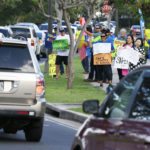Kahului roundabout pros and cons weighed
Community groups, parents, teachers and county officials rallied Thursday afternoon at the intersection of Maui Lani Parkway and Kamehameha Avenue in support of a proposed roundabout at the intersection that sees major traffic back-ups during rush hours.
In his proposed 2019 fiscal budget, Mayor Alan Arakawa has penciled in around $3.4 million for the roundabout. The Maui County Council’s Budget and Finance Committee is scheduled to discuss it today as part of its ongoing budget deliberations. Today’s session begins at 9 a.m., in the Council Chambers.
Advocates say the project will improve safety for drivers, pedestrians and bicyclists. Currently the intersection is a four-way stop. In some directions, more than 10 cars can be lined up during the morning rush. In a roundabout, or traffic circle, there are no stop signs and motorists yield while entering the circle.
The Kahului roundabout will be modeled after a roundabout in Kihei at the intersection of Liloa Drive and Piikea Avenue, said Deputy Public Works Director Rowena Dagdag-Andaya. In the five-year period prior to the roundabout being installed in Kihei, there were six motor vehicle accidents, one involving a pedestrian. But since the roundabout was installed in 2012, and up to 2017, there have been only two motor vehicle accidents and no pedestrian accidents, she said.
Laksmi Abraham, an official with the Blue Zones Project, which helped organize the rally, said the time to act on the Maui Lani proposal is now. If the proposal doesn’t pass this budget session it will take possibly another two more years for it to be built, because it possibly would need to go through another budget cycle.
“How long are we gong to wait?” Abraham asked. “Is it going to take a kid getting hit in that intersection before we do something about it?
“The bottom line is roundabouts save lives. I’d rather be proactive that reactive in this situation,” she added.
She pointed to statistics that show that roundabouts bring a 90 percent reduction in fatal collisions, 40 percent reduction in pedestrian collisions, 65 percent reduction in traffic flow delay and an 80 percent reduction in annual maintenance costs.
Blue Zones aims to improve health and quality of life. It is working with HEAL, or the Healthy Eating Active Living Coalition of Maui, to raise awareness of the roundabout, Abraham said. The county, too, has posted information on the Maui Lani Roundabout Page on Facebook. It has the support of Maui Police and Fire departments and parents, Dagdag-Andaya said.
Abraham said Blue Zones is communicating with nearly Pomaika’i Elementary School about the roundabout.
The rally was meant to be educational.
“Like anything new, people are apprehensive to accept it at first. Roundabouts are new to us, new to Hawaii. (But) they are quite popular to the rest of the world,” Abraham added.
Pomaika’i Elementary School parent Pamela Miyagawa supports the plan.
“I personally am for anything that will make the commute run a little more smoother and be safer for our kids that are walking, biking, etc. to school,” she said in an email. “I use the roundabout in Kihei, and I find it easy to navigate without any problems.”
But not everyone is convinced.
Maui Lani resident Chris Profio said he’s not opposed to traffic circles in general, but thinks one will not work at that intersection. He said he thinks that multiple turn lanes and traffic lights would work better.
The former California police officer admitted he’s not an expert in traffic-flow analysis, but he believes there would not be enough room for a properly sized roundabout.
“The plan calls for single lanes of traffic in all directions, as well as a single-lane roundabout. Single lanes of traffic in all directions already exist at this location, and the result is gridlock at peak times,” Profio said. “I think the roundabout there is going to be cramped for pedestrians and bicyclists and single lanes of traffic in all directions and the roundabout are not going to reduce traffic there.”
But Dagdag-Andaya said consultants have said the roundabout, which will be slightly smaller than the Kihei roundabout, should be sufficient to handle the traffic. It also would be large enough to accommodate buses and firetrucks.
Dagdag-Andaya said that there haven’t been many accidents at the Maui Lani-Kamehameha intersection, although she has heard of near-misses. She said she thinks people are afraid of biking and walking in the area, and the roundabout could help alleviate those fears.
The roundabout would have push-button signals where pedestrians set off flashing lights to alert motorists. There also would be small grassy medians between so pedestrians would not need to walk a long way while crossing the street to reach a safe spot.
Dagdag-Andaya said if money is put in budget for fiscal 2019, construction would probably begin in the summer of 2019, when school is out.
There would be detours in the area during construction, but she added that work would be done to minimize impact on traffic, especially at Pomaika’i.
The county will receive $610,000 for the project from Maui Lani through an agreement made years ago. Maui Lani formerly owned the intersection, Dagdag-Andaya said.
Overall, Dagdag-Andaya said statistics show that a roundabout would greatly reduce traffic: current backup with a roundabout would be four cars; with a traffic signal, 12 cars; and with the current four-way stop, 33 cars.
In 2036, models show, the backup would be 18 cars with a roundabout, 70 cars with a traffic signal and 80 cars with the four-way stop.
The county also looked at future costs: a traffic signal would cost around $13,000 annually to maintain while a roundabout would cost $2,600.
* Melissa Tanji can be reached at mtanji@mauinews.com.
- Jerome Do (from front) of Kihei; Todd MacFarlane of Pukalani; and Jaimelee Felipe and Esther Felipe of Kahului wave to motorists stalled in traffic on Maui Lani Parkway near the intersection with Kamehameha Avenue on Thursday afternoon. The event was organized by the Blue Zones Project in support of a roundabout at the busy intersection, which is near Pomaikai Elementary School. A contingent of Pomaikai teachers and area residents participated in the sign-waving. • The Maui News MATTHEW THAYER / photo
- Maui County Mayor Alan Arakawa has proposed $3.4 million for a roundabout at the often congested Maui Lani Parkway-Kamehameha Avenue intersection. A sign-waving event was staged at the intersection, which currently is a four-way stop. • The Maui News MATTHEW THAYER / photo




